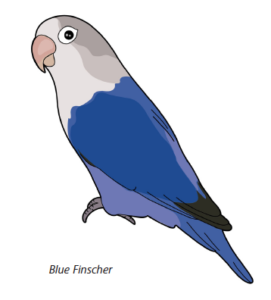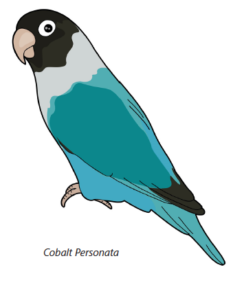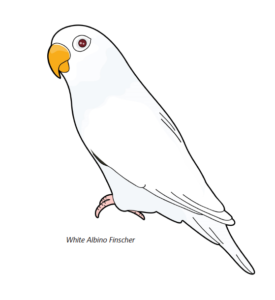Get to know the African lovebird.
I grew up knowing lovebirds were parakeets and budgies. In 1994, I started seeing African lovebirds in the Philippines.

They were mostly green in color. Their beauty fascinated me. I then began checking their worth and learned their price ranged from Php3,000 and up. That amount was huge for that time, considering its dollar conversion. In addition, I had my hands already full with my pets of that time: dogs, tropical fish, and pigeons. Yet the desire to own African lovebirds has always stayed with me.
Last year, my son and I walked around a Sunday market in Quezon City. There was a stall, which sold different kind of birds, including African lovebirds. My son Aaron saw two lutino eyerings and was excited about the prospect of having them. To show my love for my son, I bought them—but secretly, I knew inside I wanted them for me.
I always consider myself a beginner in everything, and I was excited to find out what I needed to know about African lovebirds. Information is available anywhere but we need to be careful and analyze the data we acquire. I use the formula research + evaluation + application = discovery.

My research:
• Lovebirds are small parrots
• There are nine species of lovebirds , eight of which are native to Africa, and one comes from Madagascar
• Its genus name is Agapornis (from the Greek word agape which means ‘love’, and ornis, which means ‘bird’)
• Feeds on a mixture of seeds, vegetables, fruits, and leaves• Their average lifespan is 10 to 15 years
• Species and subspecies
• Agapornis roseicollis, or peach-faced lovebird
• Agapornis personatus or yellow collared masked lovebird• Agapornis fischeri or Fischer’s lovebird
• Agapornis lilianae or Nyasa lovebird
• Agapornis nigrigenis or Black-cheeked lovebird
• Agapornis canus, or Madagascar lovebird
• Agapornis taranta or Black-winged lovebird
• Agapornis pullarius or red-faced lovebird
• Agapornis swindernianus or Black collared lovebird

Common terms used in lovebird keeping:
• Cock – Male African lovebirds
• Hen – Female African lovebirds
• Opaline – color mutation of a peach face
• Lutino – a completely yellow bird with a white rump and red eyes• Pied – having patches of two or more colors, just like various birds and other animals
• Albino – lacks normal pigmentation so its feathers are abnormally white. They have pink, normally called ‘red’, eyes• Mauve – pale purple color
• Pastel – pastel colors are the family of colors that have low to intermediate saturation and are usually described as “soothing”
• Bonded pair – paired birds that have not yet produce offspring. Some pairs may be both male and female. Other pairs may not produce fertile eggs
• Proven pair – pair lovebirds that has already produced offspring

Advanced terms that beginners would encounter but I won’t recommend you burden yourself with yet if you are a beginner:
• Mutations
• Dilute
• Dark factor
• Slaty
• Persopied
• Sable
• Spangle
My personal experiences in keeping lovebirds:
• Members of a bonded pair can find other partners
• They love to eat malunggay (Moringa oleifera) leaves• Use small grits for calcium needs. I seldom use cuttlebone because dirt tends to stick to it
• They create sound together around 12 noon and 4 PM
• I am really amused by their acrobatic movements
• Spray mist them during hot weather
• They remove seed husks when they eat
• They have a minor homing instinct.

There is a bird which visits us daily and we were able to catch it to give shelter. We named him Spy. I guess he flew out from another cage. I also tried placing our African lovebirds in an aviary, but returned them to individual enclosures or as pairs of the same color because they tend to bite other feet. Also, I cannot appreciate their individual colors because of the mixup. I now have a pair each of lutino, green personata, violet pied fischer, and white bull. I also have a single cobalt personata because its mate—a mauve personata—died.
My plans for these wonderful pets are hand-taming, breeding, and collecting all possible colors available. Just like with the discus, betta, and guppy among fish, and snakes and geckos among reptiles, no doubt the main reason for the enjoyment in collecting African lovebirds is the range of colors it can develop, and adding to these. They are naughty, active, friendly, and so much more. African lovebirds are a small package that pack a wallop of great personality. Makes me look forward to finches, cockatiels, parakeets, and budgies—but for now, I am still overwhelmed with fascination when it comes to African lovebirds.
This appeared in Animal Scene’s March 2016 issue.






